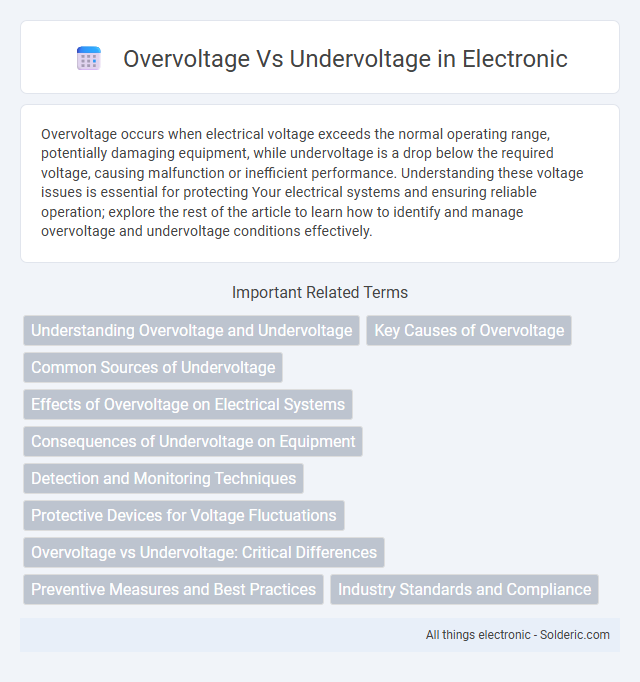Overvoltage occurs when electrical voltage exceeds the normal operating range, potentially damaging equipment, while undervoltage is a drop below the required voltage, causing malfunction or inefficient performance. Understanding these voltage issues is essential for protecting Your electrical systems and ensuring reliable operation; explore the rest of the article to learn how to identify and manage overvoltage and undervoltage conditions effectively.
Comparison Table
| Feature | Overvoltage | Undervoltage |
|---|---|---|
| Definition | Voltage level rises above the nominal range. | Voltage level falls below the nominal range. |
| Cause | Power surges, lightning, switching operations. | Faulty wiring, heavy load, power supply drop. |
| Impact on devices | Component damage, overheating, insulation failure. | Reduced performance, malfunction, device shutdown. |
| Detection Tools | Voltage monitors, surge protectors. | Voltage regulators, undervoltage relays. |
| Protection Methods | Surge protectors, voltage clamps, transient voltage suppressors. | Voltage stabilizers, uninterruptible power supplies (UPS), relays. |
| Common in | Industrial plants, power grids, lightning-prone areas. | Residential areas, overloaded circuits, aging infrastructure. |
Understanding Overvoltage and Undervoltage
Overvoltage occurs when the voltage in an electrical system exceeds the designated limit, potentially damaging equipment and causing safety hazards. Undervoltage happens when the voltage falls below the required operating level, leading to inefficient performance and possible failure of electrical devices. Understanding these voltage anomalies helps you protect your electrical systems from malfunction and optimize their reliability and longevity.
Key Causes of Overvoltage
Overvoltage occurs when the electrical supply voltage rises above the designated level, often caused by lightning strikes, sudden load reductions, or faults in the power system. Equipment failures, such as malfunctioning voltage regulators or improper transformer tap settings, also contribute significantly to overvoltage conditions. Understanding these key causes can help you protect your electrical devices and maintain system stability.
Common Sources of Undervoltage
Common sources of undervoltage include heavy electrical loads, faulty wiring, and transformer malfunctions that reduce voltage levels below the required threshold. Undervoltage can also result from long transmission distances causing significant voltage drop or sudden increases in power demand that the supply system cannot promptly meet. These conditions often lead to equipment inefficiency, malfunction, and potential damage if not properly managed.
Effects of Overvoltage on Electrical Systems
Overvoltage in electrical systems causes insulation breakdown, leading to equipment failure and increased risk of electrical fires. It induces excessive current flow, generating heat that damages sensitive components and shortens their lifespan. Persistent overvoltage also disrupts voltage-sensitive devices, resulting in operational inefficiencies and costly maintenance.
Consequences of Undervoltage on Equipment
Undervoltage can cause motors to overheat, leading to insulation damage and premature equipment failure. Electronic devices may experience erratic behavior, data corruption, or complete shutdowns due to insufficient voltage supply. Prolonged undervoltage conditions reduce operational efficiency and increase maintenance costs across industrial and domestic electrical systems.
Detection and Monitoring Techniques
Overvoltage and undervoltage detection techniques rely on voltage sensors, such as potential transformers and voltage dividers, integrated with microcontrollers or programmable logic controllers (PLCs) for real-time monitoring. Advanced systems use digital signal processing (DSP) and machine learning algorithms to enhance the accuracy of voltage anomaly detection and predict potential faults. Continuous monitoring is achieved through SCADA systems and IoT-enabled smart meters, facilitating automated alerts and protective actions to maintain electrical system stability.
Protective Devices for Voltage Fluctuations
Protective devices for voltage fluctuations include surge protectors, voltage regulators, and circuit breakers, which safeguard electrical systems from overvoltage and undervoltage conditions. Overvoltage protection involves components like Metal Oxide Varistors (MOVs) and Transient Voltage Suppressors (TVS) that clamp excess voltage, preventing damage to connected equipment. Undervoltage relays trigger disconnection to avoid malfunction or damage during low voltage events, ensuring your electrical devices operate reliably within safe voltage ranges.
Overvoltage vs Undervoltage: Critical Differences
Overvoltage occurs when the electrical voltage exceeds the designed limit, potentially damaging equipment and causing insulation failure, while undervoltage involves a drop below the required voltage level, leading to insufficient power and malfunctioning devices. Understanding these critical differences helps protect your electrical systems by ensuring voltage remains within safe operating ranges, preventing downtime and costly repairs. Effective monitoring and control devices are essential to detect and address both overvoltage and undervoltage scenarios promptly.
Preventive Measures and Best Practices
Preventive measures for overvoltage include installing surge protectors, voltage regulators, and using uninterruptible power supplies (UPS) to maintain stable voltage levels. Best practices for undervoltage prevention involve regular maintenance of electrical systems, proper grounding, and monitoring voltage levels with protective relays to avoid equipment damage. Implementing these strategies ensures reliable power supply and protects sensitive electronics from voltage fluctuations.
Industry Standards and Compliance
Industry standards such as IEC 61000-4-11 and IEEE Std 1159 provide clear guidelines for overvoltage and undervoltage conditions to ensure electrical equipment safety and reliability. Compliance with EN 50160 specifies voltage quality parameters, including permissible variations in voltage magnitude, minimizing risks of damage or malfunction in industrial systems. Adhering to these standards is critical for manufacturers and operators to maintain system integrity and avoid costly downtime or equipment failure.
Overvoltage vs undervoltage Infographic

 solderic.com
solderic.com